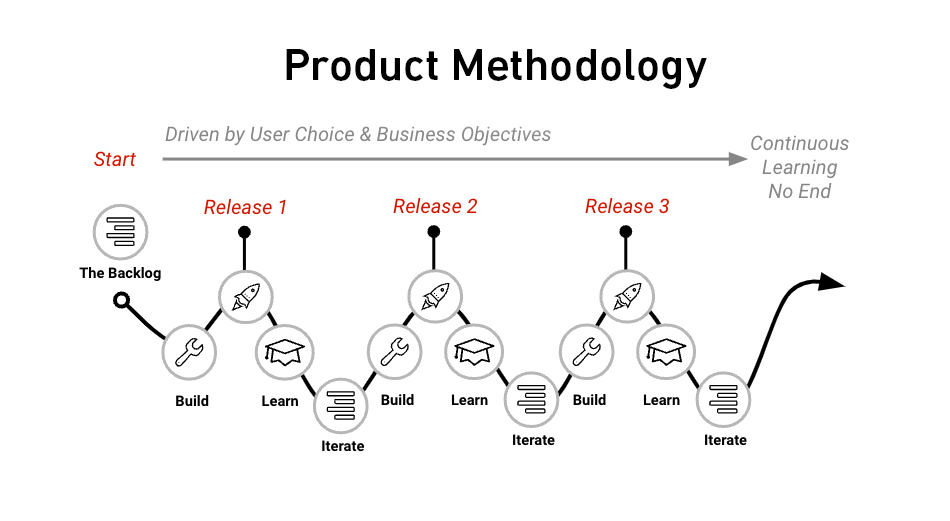
Digital product 101: what it is and how it’s delivered
To some extent, almost every business is a tech business. We’re not the first to make that assertion (and we won’t be the last), but it still gives pause to other industries like, say, an ag company when they think of themselves as tech. Stephenie Stone from M+W Group said it best when she explained:
Every company is a technology company, no matter what product or service it provides. The companies that embrace this fact are the ones that shape our world…Even companies that have a strong product and sustainable business plan struggle if they fail to connect with their customers in a technologically valid way.
That “technologically valid way” is by delivering value to their customers in a way that enables growth by outcomes instead of outputs. That’s why growth-minded companies are focusing on the needs of their customers first and developing digital products that meet those needs.
But what exactly is a digital product?
A digital product is a consumer-facing technology solution that enhances the lives of those who use it and work towards achieving specific goals or desired outcomes.
When developing a digital product, most envision a single deliverable (i.e., a website or app) and work to execute it and call it a day. In making the distinction, a true digital product:
- Competes in the market – is consumer-facing and of functional use in a B2C or B2B capacity.
- Creates monetizable value – either paid for by the user, through advertising, or other means of funding.
- Is chosen by the user – target audiences can opt-in to use it.
- Is never done – it relies on feedback and insights to continually improve and increase value.
Never miss out on insights
Stay updated on Nerdery’s news as it happens
There are four main components of digital product development:
1. Strategy and innovation
To ensure a successful digital product is to find the nexus of desirability, viability and feasibility, and that starts by understanding the current state of the business, competitive landscape and positioning. From there, you are able to create a strategy that will stand out in the market by fulfilling an unmet need or even a need that is yet to be uncovered.
Common tactics:
- Business strategy
- Product road mapping
- Business model development
2. Insights and analytics
User feedback and data are crucial early on in digital product development and planning, but also are needed throughout the build and even after the product is initially released. What is effective and relevant today won’t always be that way in the future. By investing in insights and analytics, you can pivot directions to ensure the product continues to do the job.
Common tactics:
- Qualitative/quantitative audience research (i.e., focus groups, surveys, stakeholder interviews)
- Data strategy
- Usability testing
- Marketing insights

3. Technology and engineering
Once a strategy has been developed, and insights have been gathered, the next step is to identify technology that will support your product. The software and platforms you use – custom or off-the-shelf – must align with your goals and customer needs.
Common tactics:
- Technology consulting and strategy
- Website and app development
- Cloud architecture
- Data engineering
- Quality assurance (QA)
4. User experience and design
Consumers today don’t just expect brands to know what their needs and preferences are now, but they also expect them to know what they’ll be in the future – before they even know them. User experience and design involve how the consumers will interact with the product and what technical and design features will make using the product enjoyable – so that they’ll continue to choose that product again and again.
Common tactics:
- Usability testing
- Information architecture design
- Visual design
- Prototyping and testing
How to develop a digital product
As much as a digital product is an asset, like an app or website, it’s also a way of working that makes it possible for digital products to succeed. Developing that right product at the intersection of desirability, viability and feasibility requires following a process called the product methodology.
Imagine you’re making a meal for a friend at your home, and you have your shopping budget set and prep time planned. But let’s say, once your friend arrives, you find out they are allergic to the main ingredient in your dish and can’t eat it. Had you figured out your guest’s dietary needs and preferences beforehand, you would have been able to make something else and adjust your budget and schedule accordingly instead of figuring out an alternative when it’s too late.
You can’t always predict what’s going to happen in the market five years, one year, or sometimes even six months from now, and that’s why many are moving away from traditional, linear project methodology to the digital product methodology.
Digital product methodology: how the product delivery process has evolved
Historically, the expectation for product development would be to set a budget and timeline and commit to milestones with the end result being the one-and-done product. This process is often referred to as the project methodology, where value is only attainable after each project is completed, and it requires you to commit to a plan, even if you discover it’s not the right one down the line. This approach is limiting and frankly antiquated, making it challenging to make updates in the future.
The product methodology provides a more fluid and adaptable process for developing products that allow for iteration based on learnings and user feedback through more frequent releases of core functionality to end-users. At the beginning stages of product creation, deliverables are planned and prioritized based on the client’s goals. However, after the first release, the team seeks user feedback and reprioritizes the next set of deliverables based on those learnings.


The business case for digital products
Users’ needs seem to change faster than we can keep up. According to Forrester:
Digital products create new revenue and can accelerate business transformation. But trying to design and build new digital products using the same capabilities used to create and launch physical products or even traditional enterprise software won’t work. Needs continuously evolve, especially in the digital age.
Companies that invest in digital product creation are more likely to see revenue growth. Regardless of the industry or service provided, offering digital products that align with your business goals and meet your customers’ needs will increase your organization’s perceived value and help support enduring customer loyalty.



